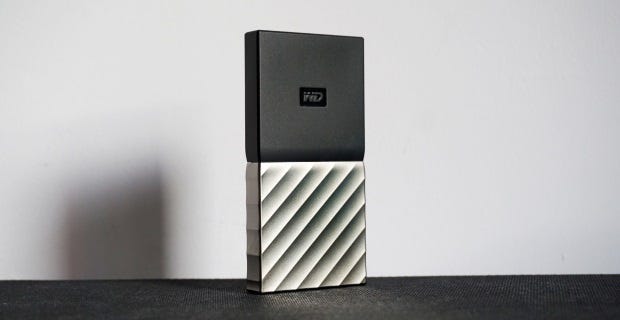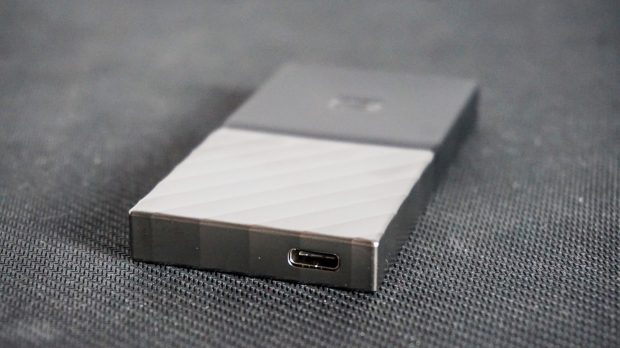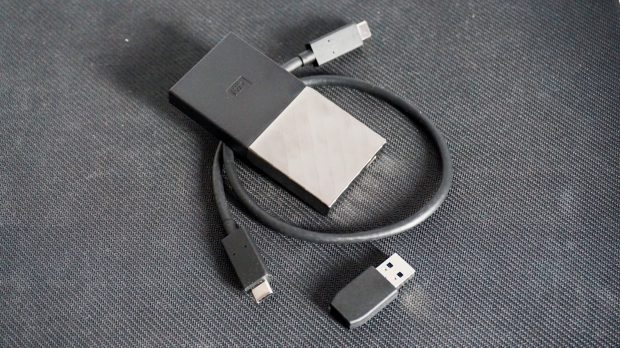WD My Passport SSD review: Good external storage that doesn't cost the earth
Pass the time
Having a fast SSD inside your PC is all well and good, but they're pretty useless if you want to transport large files to a different machine for a bit or back stuff up for safe keeping. In times like this, you need an external SSD, and today I'm taking a look at the WD My Passport SSD.
Portable storage devices have, of course, been around for donkey's years, but while external hard drives (HDDs) are much cheaper than their SSD counterparts, they're also a lot more liable to break when you chuck them in a bag due to the number of moving parts they have inside them. They're also generally a lot bigger and bulkier to carry around.
The WD My Passport SSD, by comparison, measures just 90mm long, 45mm wide and a mere 10mm deep, making it exceedingly easy to slip into a jeans or jacket pocket without much fuss. It also has 256-bit AES hardware encryption to keep it secure, and it's shock-resistant up to 6.5ft (or just under 2m), too, giving it extra durability if you accidentally send it flying because it's so damn diddly.
It's pretty nippy, too, as WD claim it can transfer files at a rate of up to 515MB/s when using its USB Type-C connector. That's not quite as fast as Samsung's portable T5 SSD that claims a 540MB/s transfer rate (a review of which is forthcoming). However, the trade-off you get is that the WD My Passport is considerably less expensive, with the 256GB model costing £87 / $100 compared to the Samsung's 250GB asking price of £108 / $124.
Luckily, the My Passport SSD isn't just limited to USB-C devices, as it also comes with a regular USB Type-A adaptor in the box - handy, considering neither my laptop or PC support USB-C. Connecting it to a regular USB port (whether it's USB2 or USB3) will naturally hinder the drive's transfer speeds a bit, but in testing I still found it put in very reasonable performance over USB3.
I started with AS SSD's copy benchmark, which tests a drive's ability to write and read files simultaneously. This generates and transfers three different types of file from the OS onto the drive - an ISO folder comprising of two large files, a programs folder with lots of little files, and finally a game folder that's made up of both big and small files.
In this test, the WD My Passport SSD was pretty much on par with Samsung's T5 (as you can see in the graph below), transferring the ISO folder at a rate of 319MB/s (taking just 3.37ms), the program folder at 152MB/s (9.27ms), and the game folder at 265MB/s (coming in at 5.21ms).
The My Passport SSD started to fall behind, however, when I put it through AS SSD's regular reading and writing tests, with its random 4K result coming in at just 21.3MB/s read and 25.9MB/s write. While its read speed is only 12% slower than the T5, its writing speed is 36% slower, making the T5 faster and more efficient overall as a standalone drive.
To be fair, I never felt like I was left hanging with the WD My Passport SSD, even when I was organising and moving large quantities of files around on the drive itself. When I moved 10GB of music files from one folder to another, for instance, the My Passport SSD completed the task in around 1m 50s. That's pretty damn quick as far as I'm concerned, and infinitely preferable to the 17m 45s I spent twiddling my thumbs waiting for my old external HDD to do the same thing.
That said, the My Passport SSD also struggled to compete with the T5 on CrystalDiskMark's intensive random 4K 8-thread-8-queue test as well, reading files at just 24.4MB/s and writing them at 29.3MB/s. The T5, by comparison, managed 181.7MB/s read and 183.8MB/s write.
In fairness, this is the kind of workload you'd expect to see taking place on a server or workstation rather than an external SSD, so it may be a slightly unfair comparison. However, it might come into play if you end up transferring a lot of files to the My Passport SSD from multiple locations at the same time when you're backing up files, for example, or upgrading to a new PC or laptop and need to get all your files off your old one. In cases like this, the T5 will likely get the job done a lot faster. It's just up to you whether you want to pay a bit more for the privilege.
Personally, I think I'd be perfectly happy with the WD My Passport SSD if I was looking to buy one at 256GB, as I'd rather have the extra £20 to spend on something else. However, when you move up to the 512GB ballpark, prices are so close together that I'd probably be tempted to go with the T5 instead, as both cost around £170 in the UK at time of writing, and the T5 will only set you back another $10 over the $150 My Passport SSD in the US. It's worth noting the T5 is only a 500GB SSD rather than 512GB, but given the tiny difference in price and the T5's arguably superior performance, you'd probably be better off going with the Samsung.
At 1TB, however, the WD goes back to being the cheaper, more cost effective external SSD, costing £279 / $297 as opposed to the T5's £330 / $350. Again, I'd be willing to trade performance for a lower price in this case, but those after the middle capacity will probably feel the benefit of the T5 a bit more.












